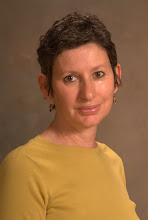Nothing is ever simple. I received most, but not all, of my pathology report today. To put the information into context, you'll have to gain some more medical knowledge, so let me do a little explaining.
We have yet to discuss DCIS in any detail here, but it's now become an important component of the story. Ductal Carcinoma In Situ (DCIS) is considered a precancerous condition. It develops in the ductal system of the breast, but won't harm the patient unless it breaks out, or becomes "invasive." The results of my biopsy a few weeks ago noted the presence of both DCIS and invasive ductal carcinoma. You're correct if you're thinking that one condition leads to the other.
Some women are diagnosed while they are still in the DCIS phase, because radiologists may detect it as microcalcifications on a mammogram. (Well, not on my mammograms, but now I am covering old ground.) The treatment for DCIS varies and depends on how aggressive the cells appear to be and on how widely it has spread through the ductal system. A very widespread occurrence of DCIS warrants a mastectomy.
Okay, enough background. Time to get back to the pathology report at hand. First, the very excellent news is that we continue to see no "metastatic carcinoma," or cancer that has spread beyond the breast. All of the studies of the lymph nodes continue to be negative, although one study looking for "micrometastasis" in the nodes isn't back yet. But no one seems concerned about this.
While no spread of the cancer is great, there may be a different worry. While the surgeons achieved good margins around the mass, they weren't as happy with the margins around the DCIS. Specifically, they didn't like the border on the south side, or in the 5 to 6 o'clock hour. Apparently, I had more DCIS than they anticipated. This is a little like the federal government doing a deportation sweep in Orange County so they can return the illegal farmworkers to Mexico, and then learning, after the raid is over, that they may have missed some farmhands who were planting in San Diego.
The plan now is to seek more expert opinion so we can decide the best course of treatment. Next week, I'm heading off to see a radiation oncologist at St. Joseph's Hospital in Burbank. Surprisingly, the breast surgeon at USC/Norris is sending me off campus, because he believes the radiation doctors at St. Joseph's are the best. One possible outcome is that the radiation group could decide that the margin we achieved is acceptable, as long as the area is radiated. Another scenario is that we all agree that the margin is too close for comfort, and several months from now, the surgeon re-excises, or takes additional tissue on the southern side. The final choice is to go back and do a mastectomy.
Information on the cancer's hormonal structure is still not back from the lab. This data, which is expected on Monday, will eventually be directed to yet another specialist, a medical oncologist. The medical oncologist decides whether chemo is in the cards, and if so, the type, dosage, duration, etc. The medical oncologist will also contribute to the discussion on the DCIS margins.
The short answer is that it's complicated. But then, medical decisions never seem to be easy. Risk is always the variable. What is an acceptable level of risk for recurrence? There is a weird irony to this story. Almost 20 years ago, I delivered my first baby at St. Joseph's Hospital. As a new mother, I appreciated that my body produced milk to feed my hungry infant. Now, my once reliable milk-delivery system is spinning out of control, and doctors at St. Joseph's will put energy (literally) into suppressing it. As parents, we worry about the risks our kids face all time, and we always want a safety margin in place. But how wide does it have to be? The odd thing is that I'm now the focus of this question, and it's a very peculiar place for me to be.
11/29/07
Subscribe to:
Post Comments (Atom)





No comments:
Post a Comment